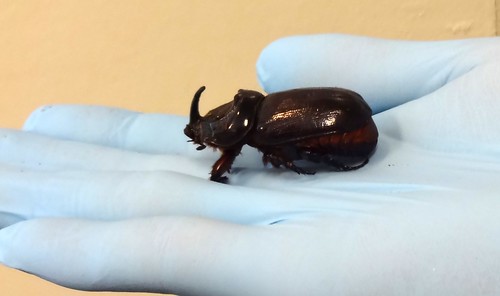Big, creepy, and horned, the coconut rhinoceros beetle (CRB) loves to feed on—and kill—coconut and other palms, banana plants, and more. This invasive species, detected in Hawaii in December 2013, makes the perfect poster child for USDA’s Invasive Plant Pest and Disease Awareness Month—a child only its mother could love.
How did it get here? And how can we prevent the spread of damaging, invasive species like this unwanted, oversized beetle? These are great questions to consider as USDA kicks off Invasive Plant Pest and Disease Awareness Month. Throughout April, we’re raising public awareness about the threat of invasive species and informing people how to prevent their spread—so we’ll face fewer surprises like the CRB.
We haven’t determined exactly how this beetle snuck into Hawaii, but we have some good ideas. It probably hitchhiked on containers, or with plants and plant material moving in cargo or passenger baggage. From there, it could have spread on its own, or it could have kept on hitchhiking, in plants, plant material and debris, mulch, soil, or hidden on pallets. People can unknowingly spread invasive pests across states, countries, continents, and oceans.
That’s why USDA created its Hungry Pests outreach program, to empower the public with the knowledge of how to Leave Hungry Pests Behind. Invasive Plant Pest and Disease Awareness Month is the perfect time to visit HungryPests.com, which has a wealth of visually compelling information on invasive species. Use the site’s interactive maps to learn which pests are in your state and which ones threaten it. Meet some destructive invaders, such as the giant African snail, Asian longhorned beetle, and citrus greening disease. Most importantly, learn the Seven Ways to Leave Hungry Pests Behind so you don’t accidentally spread destructive pests like the CRB.
The stakes are extremely high. Each year, invasive pests cost our economy billions of dollars by damaging crops, killing trees, requiring costly response efforts, and closing foreign markets to U.S. products from infested areas. USDA and its partners work very hard to keep invasive pests out of the country and combat those that sneak in, but we can’t do it alone—we need your help. So this month, be on the lookout for videos, articles and social media buzz on invasive species and how to stop their spread. Start by visiting HungryPests.com, and join the conversation on the Hungry Pests Facebook Page.
In the meantime, in Hawaii, USDA and state officials are hanging traps to determine the size of the CRB-infested area, removing mulch piles that CRBs use as breeding sites, and informing the public how to spot and report the CRB. If only someone had left that Hungry Pest behind.
- See more at: http://blogs.usda.gov/2014/04/03/help-usda-stop-invaders-that-could-devastate-u-s-crops-and-forests/#sthash.e5EgatgX.dpuf

